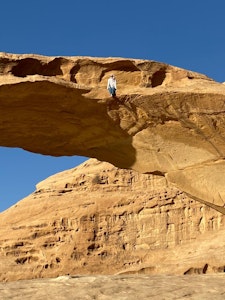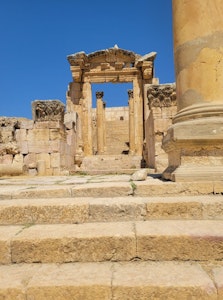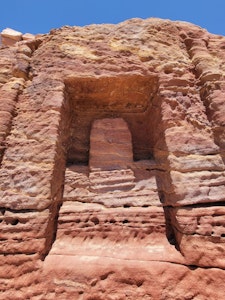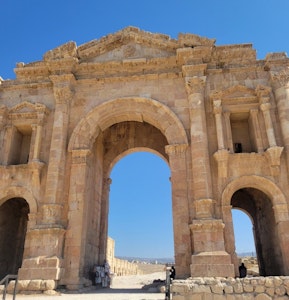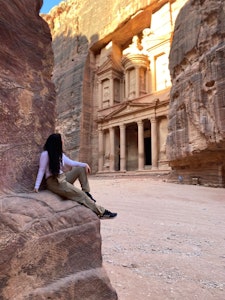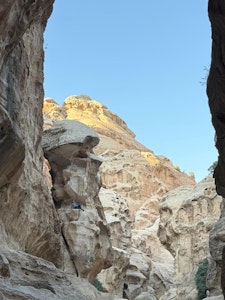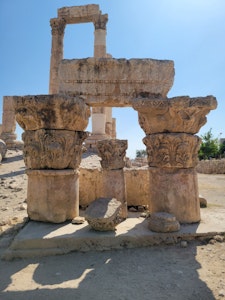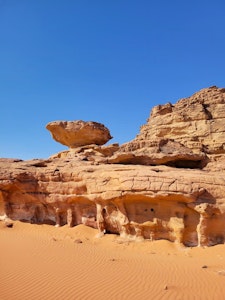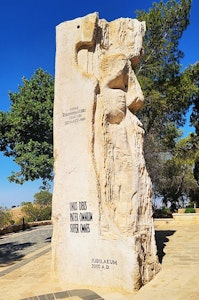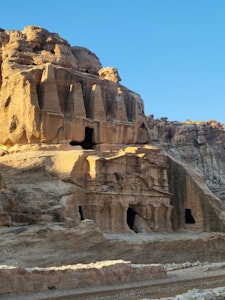Desert Echoes: Stories from Jordan’s Ancient Past and Vibrant Present

Raven Wentworth
Jordan had been tugging at my curiosity for years. My dad, who’s in the Air Force, spent much of my childhood deployed in the Middle East. He always came home with stories of hospitality, resilience, and the peaceful culture that existed beyond the headlines.
I’d always wanted to see this region for myself, and although Jordan is not one of the countries my dad visited, it felt like the perfect place for me to begin. Jordan is geographically central and culturally rich, home to Petra and the Dead Sea, and is #72 on the global peace index (for reference, the United States is #128).
That said, I do think it’s important to preface that my trip started days after Israel attacked Iran. As is always my thinking when working with a reputable tour group: if it weren’t safe, the trip wouldn’t run. Local guides and regional experts are far better equipped to assess conditions than I could ever be from my home in Arizona.
Still, the start was a little uncertain. Cairo’s airport departure board was lit up with cancellations, and we weren’t sure we’d make it. But our flight to Amman took off on time and landed smoothly. By the time we arrived, our group had shrunk from 12 to 8 — and honestly, that smaller size ended up being a gift.
Jerash and the Dead Sea: Rome, Ruins, and Salt
We kicked things off at Jerash, a stunning Roman city tucked into the hills of northern Jordan. It was a major trading hub where ancient roads met — silk, spices, and frankincense flowing through gates named after the cities they lead to: Philadelphia (now Amman) and Damascus. The main road, cardo maximus, diverted traffic north towards Europe and south towards Africa.
The site has two amphitheaters, and while much smaller than Rome’s Colosseum, we had them entirely to ourselves. Our group ran around, sang, climbed, and play-fought like gladiators on the arena floor— it was chaotic and joyful in a way that historical sites rarely allow.
That afternoon, we headed to the Dead Sea, descending to the lowest point on Earth. We entered through a resort and down through a garden with a series of signs along the path that showed where the waterline used to be every five years — a sobering reminder of how fast it was disappearing. We only floated for about 25 minutes before our skin started tingling from the briny water, so I scooped up a perfectly formed palm-sized chunk of salt and a vibrant red stone to take home and we retreated to the adults-only pool at the resort.
Mt. Nebo and Karak Castle: Prophets, Crusaders, and Lost Histories
It wasn’t until arriving in Jordan that I realized what an important pilgrimage site the country is. We visited Mount Nebo, the biblical site where Moses glimpsed the Promised Land after 40 years in the desert. The skies were clear, and we could see all the way to Jericho and Jerusalem — a rare view that made the story feel almost tangible. On the hill was the Moses Memorial Church filled with intricate mosaics and a nearby museum with additional pieces found at the site.
Later that day, we visited Karak Castle, a massive Crusader fortress perched high above the valley. Here we learned about the former resident Raynald of Chatillon, a warlord infamous for raiding peaceful trade caravans traveling between Damascus, Jerusalem, and Mecca. His cruelty became legendary, eventually drawing the attention of Saladin, the great Muslim general who would go on to liberate Jerusalem.
Saladin laid siege to Karak, but even in war, his sense of honor stood out — sending Raynald a horse when his fell ill and offering him a drink of water before personally executing him. The history of Saladin was one of many stories I learned about in Jordan that were both fascinating and never included in social studies curriculum.
Jordan’s written history begins with biblical accounts of the ancient Ammonite, Edomite, and Moabite kingdoms, before falling under the control of a series of major empires: the Assyrians, Babylonians, Persians, Hellenistic successors, Romans, and Byzantines. In the last millennia, the region was ruled by successive Islamic caliphates for 600 years before being absorbed by the Ottoman empire.
It was during World War 1 that the Hashemite family from Mecca joined with the British (famously represented by Lawrence of Arabia) to push out the Ottomans before the British and the French divided the whole region into the 22 modern Arab countries we know today. The royal family of Jordan is descended from the same Hashemites that lead the revolt.
Little Petra and the Spirit of the Nabataeans
The next stop was Little Petra, a quieter and more intimate version of its famous sibling. We were the only visitors that afternoon, and with the sun dipping into shade between the rocks, I had the space to climb, explore, and imagine it as the bustling outpost it once was. Much to my delight, it looked like there were stairs carved all over the canyon walls, perfect for climbing. I later learned they weren’t stairs at all, but flood breaks designed to slow down rushing water and direct it into massive cisterns. Along the narrow canyon, large rooms are carved out, one for each caravan, with an irrigation system carved into the stone to move water from the cisterns into the carved caravan rooms.
The following morning, we tackled Petra itself — and it’s so much more than one narrow canyon and the iconic Treasury. Petra is a sprawling network of hiking trails and carved monuments, once a thriving Nabataean city. The Nabataeans traded with everyone: Egyptians, Greeks, Mesopotamians, Romans, and more. They paid homage to everyones gods and blended artistic styles so that travelers felt welcome no matter where they came from. And as a crystal girly from Tucson, I loved learning that their main deity was Dushara — God of rocks. An A+ Ancient society in my books.
We hiked up to the Monastery, one of the most famous sites in Petra. After about 800 stone steps, the path opens up to a large clearing. It was so empty that day, there wasn’t a single person standing in front of it to give a hint that as we walked further into the clearing, it was towering right behind us, and the surprise when we turned made it more awe-worthy and magnificent.
After lunch at a restaurant inside the park, I tackled a second hike to the High Place of Sacrifice. This one was less about a single monument and more about the panoramic views — Petra from above, mountains and ridges and canyons with barely a hint of the intricate carvings hidden deep within them.
Petra is Jordan’s most iconic landmark for good reason. I can’t remember a time when I wouldn’t have recognized the Treasury, carved into that unmistakable red rock. But before this trip, I couldn’t have told you anything about the people who built it. The Nabataeans didn’t disappoint: masters of hospitality, craftsmanship, and water engineering, an impressive ancient civilization.
Wadi Rum: Bedouin Trails and Earth-Cooked Feasts
From Petra, we went to Wadi Rum, the legendary desert that’s doubled for far away planets in more than a few sci-fi films. We spent hours racing across the sand in trucks, stopping to climb sandstone outcrops, learn about Bedouin life, and watch the sun set over the desert. Gazing out at the vast, untouched landscape, I couldn’t decide whether I’d landed on Mars or Arrakis.
That night, we ate zarb, a traditional Bedouin meal cooked underground. Chicken, lamb, and vegetables slow-roasted beneath the sand to contain the heat. After showing what I suppose was a concerning level of interest in how to replicate the method back home, I was firmly warned that if done incorrectly, it explodes. (Duly noted but still tempted after returning to this Arizona heat).
Our tour used to stay in actual Bedouin tents, but these days, the accommodations are permanent tent-shaped lodges with real walls, private bathrooms, and showers. The only thing missing was air conditioning since the site was fully solar powered, but with doors and windows left open before dark and mosquito nets hung over the beds, we slept perfectly well.
Aqaba and Al-Safi: Sea Breezes and Village Kitchens
Our final days took us to Aqaba, a sunny Red Sea town with a laid-back, seaside energy. While some of our group went snorkeling, I grabbed brunch with a few groupmates before wandering over to a Crusader-era castle tucked inside a public park. Its winding staircases reminded me of an MC Escher drawing- never quite sure where a staircase would take me, but trusting I’d eventually pop back out into the courtyard.
That night, I tried mansaf, Jordan’s national dish a rich, savory combination of lamb, rice, and fermented yogurt, followed by a slice of kunafa the size of my head from a local sweet shop that has been on my foodie bucket list for years. Families filled the outdoor seating area, kids practiced their English, and an older man passed out tiny cups of coffee and water from a sidewalk stand. It was one of those small, joy-filled evenings that gives you a true glimpse of everyday life.
One of the reasons I love and have decided to travel with G-Adventures is their commitment to uplifting local communities through tourism. In every tour you get to visit a local project supported by the Planeterra Foundation, G-Adventures’ philanthropic partner. In Jordan, we stopped at the Al Safi Community Kitchen in Jordan’s fertile farming region. The kitchen was started by Abd, a local man who wanted to create more economic opportunity for his village. The project employs women like Hana and Rania, and together they’ve turned traditional Jordanian cuisine into a form of food tourism that supplements agricultural incomes. We shared a beautiful, home-cooked meal made from local ingredients, listened to their stories, and left with a cookbook filled with their favorite recipes. I can’t wait to try them at home.
Final Views and Farewells
We spent our last hours in Amman at the Citadel, the highest point in the city. From there, you can see the layers of history across site, remnants of the Ammonites, Greeks, Romans, Byzantines, and Umayyads, who all valued the prime positioning of the hill. It’s also home to the Jordan Archaeological Museum, where I wandered through rooms filled with artifacts from all of the cities we had visited, spanning the many eras that have passed over this land. It was the perfect place to browse unguided, quizzing myself on everything I’ve learned.
Jordan may not be on everyone’s radar, but it absolutely should be. It’s a country where the past is visible in every canyon and castle and where the present feels deeply rooted and proud. I felt safe, welcomed, and inspired the entire time I was there. I can’t wait to return and see even more of what this incredible country has to offer.
Contact Raven
Pictures from this trip
